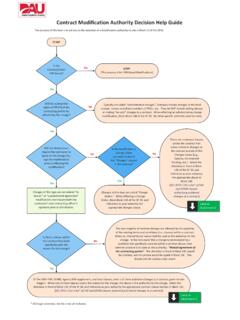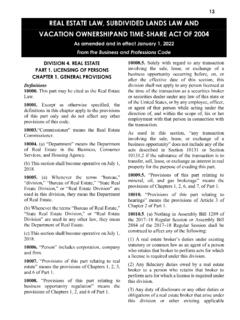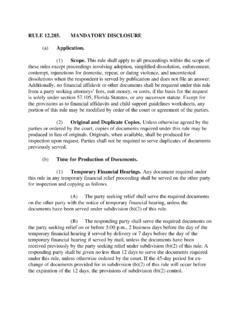Transcription of Lease modifications ten comprehensive examples - Deloitte
1 1 Lease modifications ten comprehensive examples 2 Foreword IFRS 16 Leases was issued in January 2016 and it is effective for accounting periods beginning on or after 1 January 2019. While not a large standard in terms of pages when compared to other more recent standards, it is a standard that is raising many practical and interpretational issues. modifications is a particular area which has raised issues and the devil is in the detail. This very practical publication runs through some of the accounting for these modifications with a series of ten scenarios that build on the various permutations of Lease modifications in a logical manner, explaining the principles and concepts while providing easy to follow numeric examples . A practical and hopefully very useful guide. Stephen Taylor Partner Emeritus July 2019 3 Contents Foreword 2 Contents 3 Introduction 4 The focus of this publication 5 comprehensive examples 7 Pre- modification fact pattern for all ten examples 7 example 1 changing the consideration 9 example 2 extending the Lease term 11 example 3 leasing additional space at market rates 13 example 4 leasing additional space at off-market rates 16 example 5 extension plus leasing additional space at market rates 19 example 6 shortening the Lease term 22 example 7 reducing the leased space 25 example 8 reducing the leased space plus shortening the Lease term 29 example 9 reducing the leased space plus extending the Lease term 34 example 10 shortening the Lease term plus leasing additional space at off-market rates 39 Appendix I relevant IFRS 16 guidance 45 Appendix II relevant Deloitte guidance 48 Contacts 49 4 Introduction Lease modifications .
2 Numbers and journal entries IFRS 16 Leases contains detailed guidance on how to account for Lease modifications . A Lease modification is defined as a change in the scope of a Lease , or the consideration for a Lease , that was not part of the original terms and conditions of the Lease . A Lease modification includes adding or terminating the right to use one or more underlying assets, or extending or shortening the contractual Lease term. IFRS 16 s Lease modification guidance can be summarised into the diagram overleaf. Broadly speaking, a Lease modification is accounted for in one of two ways: 1. It is treated as a separate Lease (IFRS ); or 2. It is not treated as a separate Lease (IFRS ). As can be seen from the diagram, a modification will only be treated as a separate Lease if it involves the addition of one or more underlying assets at a price that is commensurate with the standalone price of the increase in All other modifications are not treated as a separate Lease .
3 If a modification is a separate Lease , a lessee applies the requirements of IFRS 16 to the newly added asset independently of the original Lease . The accounting for the original Lease continues unchanged. See example 3. In contrast, if a modification is not a separate Lease , the accounting reflects that there is a linkage between the original Lease and the modified Lease . The existing Lease liability is remeasured with a corresponding adjustment to the RoU asset on the effective date of the modification . See examples 1 and 2. If the modification involves the addition of an underlying asset at off-market rates, we believe the newly added asset should be recognised only when that asset is made available for use by the lessee see example 4. In the case of a reduction in the scope of the Lease , this will result in a modification gain or loss in profit or loss. See examples 6 and 7. A further point to note is the need to disaggregate an existing single Lease liability and RoU asset into separate Lease components if only some of the Lease components are modified or if they are modified to a different extent.
4 See examples 7, 8 and 9. 1 For an addition of a RoU asset to be accounted for as a separate Lease , the increase in consideration must be commensurate with the standalone price for the increase in scope and any appropriate adjustments to that standalone price to reflect the circumstances of the particular contract (IFRS (b)). For ease of reference, that notion has been shortened to an increase in consideration that is at market rates throughout this publication. See appendix I for further elaboration. 5 * DoM: Effective date of the modification Appendix I to this document reproduces the relevant IFRS 16 definitions and guidance on Lease modifications together with explanations on some of those concepts. Appendix II contains links to further Deloitte guidance on modifications . The focus of this publication In our earlier publication Lease modifications extending the Lease term issued in May 2019, we discussed (1) what constitutes a Lease modification , (2) when a Lease modification should be accounted for, and (3) what the impact of a Lease modification is on the Lease term.
5 In this publication, we build on that foundation and discuss other types of Lease modifications . Specifically, we have created ten comprehensive numerical examples to illustrate how to account for different types and permutations of Lease modifications . These permutations are summarised in the matrix below: Changes that are not part of the original terms of the Lease Change in considerationChange in scopeExtending Lease termAdding assetsAt standalone priceNot at standalone priceRemoving assetsShortening Lease termRemeasure Lease liability against RoU asset on DoM* (Ex 1, 2) New asset: separate Lease Existing asset: no change (Ex 3) On DoM: 1) Allocate modified consideration 2) New asset: account for on commencement date Existing asset: remeasure Lease liability against RoU asset on DoM (Ex 4) On DoM: 1) Reduce RoU asset and Lease liability in proportion to the reduction in scope 2) Recognise difference in P/L 3) Adjust Lease liability to modified amount against RoU asset (Ex 6, 7) 6 Space leased Lease term Unchanged Increase Decrease Unchanged NA Ex 3 & Ex 4 example 7 Longer example 2 example 5 example 9 Shorter example 6 example 10 example 8 Change in consideration.
6 example 1 Abbreviations DoM Effective date of the modification IBR Lessee s incremental borrowing rate Per annum P/L Profit or loss (income statement) RoU asset Right-of-use asset See Appendix I for relevant definitions and explanations. 7 comprehensive examples Pre- modification fact pattern for all ten examples Lessee leases office space from Lessor with original terms as follows: Size of office space leased: 5,000m2 Lease term: 5 years from 1 January 20x1 to 31 December 20x5 with no extension or termination options Lease payments: CHF100,000 payable annually in arrears IBR2: 5% Lessee has a December year-end. In each of the examples below, Lessee and Lessor agree to amend the original lease3 on 1 January 20x3. All Lease payments are paid annually in arrears. Observation In practice, there is usually a time gap between when the negotiation is finalised ( the effective date of the modification ) and when the revised terms take effect ( when the extended term starts or when a new asset is made available for use by the lessee).
7 This has an impact on the recognition and measurement of the Lease liability and the RoU asset. We have incorporated this into the examples below by setting the date when the revised terms take effect after the effective date of the modification . 2 Assume the implicit rate in the Lease cannot be readily determined. 3 The accounting would be the same if the lessee and the lessor had incorporated the terms of the modification in a new agreement as opposed to amending the original Lease . See the Deloitte publication Lease modifications extending the Lease term issued in May 2019 for details. 1 Jan x31 Jan x4 Effective date of modification Revised terms take effect 8 The pre- modification RoU asset and Lease liability on the effective date of the modification , 1 January 20x3, are as follows: CHF RoU asset Balance 1 Jan 20x1 Present value of five payments of CHF100,000 discounted at 5% 432,948 Accumulated depreciation (432,948/5*2) (173,179) Balance 1 Jan 20x3 259,769 Lease liability Present value of three payments of CHF100,000 discounted at 5% 272,325 9 example 1 changing the consideration modification : Lessee and Lessor agree on 1 January 20x3 to reduce the annual Lease payments to CHF97,000 for the remaining three years.
8 The IBR on 1 January 20x3 is 6% Analysis The change in consideration is accounted for on 1 January 20x3 being the effective date of the modification (IFRS ). Lessee remeasures the Lease liability to reflect three modified Lease payments of CHF97,000 discounted at a revised IBR determined on 1 January 20x3 of 6%, which amounts to CHF259,282. The difference of CHF13,043 between the original Lease liability (CHF272,325) and the modified Lease liability (CHF259,282) on 1 January 20x3 is adjusted against the RoU asset. Lessee records the following journal entry on 1 January 20x3: JE 1 CHF CHF Dr Lease liability 13,043 Cr RoU asset 13,043 CHF100k CHF97k 10 The RoU asset and Lease liability in relation to the modified Lease are as follows: Lease liability RoU asset Beginning balance 6% interest expense Lease payments Ending balance Beginning balance Depreciation Ending balance Year CHF CHF 20x3 Pre-m* 272,325 259,769 Adj* (13,043) (JE 1 above) (13,043) (JE 1 above) Post-m* 259,282 15,557 (97,000) 177,839 246,726 (82,242) 164,484 20x4 177,839 10,670 (97,000) 91,509 164,484 (82,242) 82,242 20x5 91,509 5,491 (97,000) - 82,242 (82,242) * Pre-m = pre- modification Adj = adjustment Post-m = post- modification 11 example 2 extending the Lease term modification .
9 Lessee and Lessor agree on 1 January 20x3 to extend the Lease upon expiry from 1 January 20x6 for two years at an annual Lease payment of CHF105,000. The IBR on 1 January 20x3 is 6% Analysis As the modification does not add the right to use one or more underlying assets, it is not accounted for as a separate Lease . Instead, it is accounted for at the effective date of the Lease modification , which is 1 January 20x3. Accordingly, Lessee remeasures the existing Lease liability on 1 January 20x3 based on the modified Lease payments using the IBR on that date (IFRS ). A corresponding adjustment is made to the RoU asset (IFRS (b)). Lessee records the following journal entry on 1 January 20x3: JE 1 CHF CHF Dr RoU asset 156,608 Cr Lease liability 156,608 To remeasure the Lease liability to reflect the modification . This represents the difference between the original Lease liability (CHF272,325) and the modified Lease liability (CHF428,933) on 1 January 20x3.
10 The modified Lease liability of CHF428,933 is calculated as the present value of three payments of CHF100,000 from 20x3 to 20x5 and two Lease payments of CHF105,000 from 20x6 to 20x7, all discounted at 6%. (CHF100k ) (CHF105k ) (CHF105k ) 12 The RoU asset and Lease liability in relation to the modified Lease are as follows: Lease liability RoU asset Beginning balance 6% interest expense Lease payments Ending balance Beginning balance Depreciation Ending balance Year CHF CHF 20x3 Pre-m 272,325 259,769 Adj 156,608 (JE 1 above) 156,608 (JE 1 above) Post-m 428,933 25,736 (100,000) 354,669 416,377 (83,275) 333,102 20x4 354,669 21,280 (100,000) 275,949 333,102 (83,275) 249,826 20x5 275,949 16,557 (100,000) 192,506 249,826 (83,275) 166,551 20x6 192,506 11,550 (105,000) 99,057 166,551 (83,275) 83,275 20x7 99,057 5,943 (105,000) - 83,275 (83,275) - 13 example 3 leasing additional space at market rates modification .













